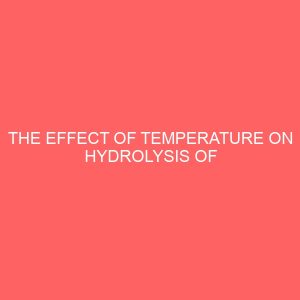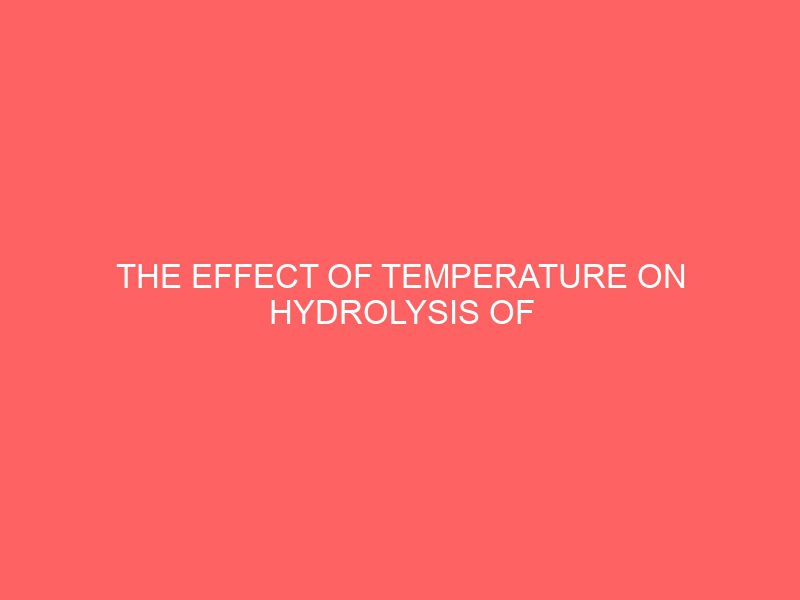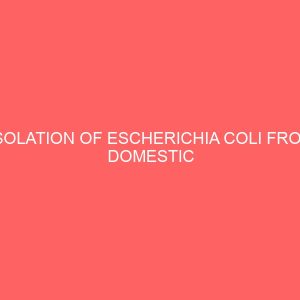Description
ABSTRACT
The effect of concentration of hydrochloric acid on hydrolysis of cellulose sawdust to glucose was studied on this research project and the steps obtained to achieve this project involved treatment of sawdust cellulose with different concentrations of the acid at constant temperature of 80 350k for 30mins. This was followed by glucose analysis, some analysis or experiments were done on acid hydrolysis in order to study the effect of HCL acid on the hydrolysis of cellulose to glucose. The process used in this hydrolysis was acid hydrolysis in which HCL acid was used at constant temperature of 80oC and the sawdust used was obtained by grinding wood with saw was weighed and mixed with water . Secondly, during this analysis/experiment, it was observed that hydrochloric acid hydrolyzed well from the readings gotten from each result that was carried out during the analysis. Then lastly, glucose analysis was carried out to determine the absorbance and glucose concentration. It was noticed that the best concentration of HCL acid during hydrolysis yields glucose concentration of 0.127g or 1.270.
CHAPTER ONE
1.1 Introduction
Cellulose is the name given to a long chain of atoms consisting of carbon, hydrogen and oxygen arranged in a particular manner it is a naturally occurring polymeric material containing thousands of glucoselike rings each of which contain three alcoholic OH groups. Its general each of which contain three alcoholic OH groups. Its general formula is represented as C6H1005n. the ohgroups present in cellulose can be esterifies or etherified, the most important cellulose derivatives are the esters.
Cellulose is found in nature in almost all forms of plant lifes, and especially in cotton and wood. A cellulose molecule is made up of large number of glucose units linked together by oxygen atom. Each glucose unit contains three3 hydroxyl groups, the hydroxyl groups present at carbon6 is primary, while two other hydroxyl are secondary. Cellulose is the most abundant organic chemical on earth more than 50 of the carbon is plants occurs in the cellulose of stems and leave wood is largely cellulose, and cotton is more than 90 cellulose. It is a major constituent of plant cell walls that provides strength and rigidity and presents the swelling of the cell and rupture of the palms membrane that might result when osmotic conditions favor water entry into the cell. Cellulose is a fibrous, ought, waterinsoluble substances, it can be seen in cell walls of plants, particularly in stalks, stems, trunks and all woody portions of the plant.
1.2 Definition of Terms
Hydrolysis: means hydro water lysis splitting or breaking down of a chemical bond by the addition of water H2O, it is by the introduction of the elements that make up water hydrogen and oxygen. The reactions are more complicated than just adding water to a compound, but by the end of a hydrolysis reaction, there will be two more hydrogens and one more oxygen shared between the products, than there were before the reaction occurred.
Hydrolysis of cellulose therefore is the process of breaking down the glucosidic bonds that holds the glucose basic units together to term a large cellulose molecule, it is a term used to describe the overall process where cellulsose is converted into various sweeteners.
Sugar: is the generalized name for a class of chemically related sweet flavored substances, most of which are used as food. They are carbohydrates, composed of carbon, hydrogen and oxygen. There are various sugar derived from different sources. Simple sugars are called monosaccharides and include glucose cellos known as dextrose, fructose and galactose. The table or granulated sugar most customarily used as food is sucrose, a disaccharide other disacclarides include maltose and lacoose. Chemicallydifferent substances may also have a sweet taste, but are not classified as sugar but as artificial sweeteners.
1.3 STATEMENT OF THE PROBLEM
The new government policies and economy through low quality products has imposed motivated researchers to explore the numerous domestic, industrial and economic importance of the Nigerias major waste product which is cellulose which forms the bedrock of this project.
1.4 SCOPE AND OF STUDY LIMITATIONS
This study is aimed at estimating the impact of some areas hindering the subject/project matter disadvantages the cellulose.
It is obvious that cellulose materials have been used, including newspaper, carboard, cotton, straw, sawdust, hemp and corncob. Monticell was insulated with a form of cellulose. Modern cellulose insulation, made with recycled newspaper using grinding and dust removing machines and adding a fire retardant, began in the 1950s and came into general use in the U.S during the 1970s.
The R value Rule placed clear limitations on the claims that manufacturing and marketing firms can make about their product, then also the effect of regulations by the CPSC put most of the small producers of cellulose insulation out of business. The costs incurred by increasing fire testing made cellulose more expensive and the bad publicity helped decrease demand.
1.5 OBJECTIVES
The principal aim of undertaking this project is to determine the effect of concentration of acid on the yield of glucose production by acid hydrolysis of cellulose.
Hydrolysis of cellulose into glucose using different concentration of hydrochloric acid.
Calculating and quantifying the yield of glucose from hydrolysis of cellulose using HCL acid.
In the experiment, cellulose from variety of sources will be subjected to depolymerization conditions








Reviews
There are no reviews yet.